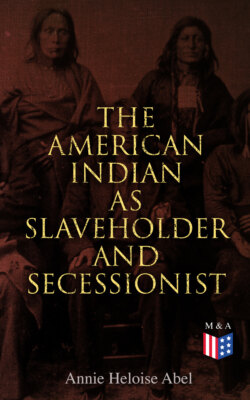The American Indian as Slaveholder and Secessionist

Реклама. ООО «ЛитРес», ИНН: 7719571260.
Оглавление
Annie Heloise Abel. The American Indian as Slaveholder and Secessionist
The American Indian as Slaveholder and Secessionist
Table of Contents
PREFACE
I. THE GENERAL SITUATION IN THE INDIAN COUNTRY, 1830-1860
II. INDIAN TERRITORY IN ITS RELATIONS WITH TEXAS AND ARKANSAS
III. THE CONFEDERACY IN NEGOTIATION WITH THE INDIAN TRIBES
IV. THE INDIAN NATIONS IN ALLIANCE WITH THE CONFEDERACY
APPENDIX A—FORT SMITH PAPERS
APPENDIX B—THE LEEPER590 OR WICHITA AGENCY PAPERS
SELECTED BIBLIOGRAPHY
I. GENERAL ACCOUNT OF DOCUMENTARY SOURCES
Footnotes:
Отрывок из книги
Annie Heloise Abel
The Slaveholding Indians Series
.....
The position of the Indians in the Leased District was serious in the extreme. They lived in mortal terror of the Texans and their agent, the man placed over them by the United States government, was now an avowed secessionist. He was a Texan and declared, as so many another southerner did from General Lee down, that honor and loyalty compelled him to go with his state. In February, he had been in Washington City, settling his accounts with the government and estimating for the next two quarters in accordance with the rulings and established usage of the Indian Office. On his way west and back to his agency, he was waylaid by a man of the name of “Burrow,” very probably Colonel N. B. Burrow, acting under authority from the state of Arkansas, who despoiled him of part of his travelling equipment and then suffered him to go on his way.148 Leeper reached his agency to find the Indians greatly excited. He endeavored to allay their fears, assuring them that the Texans would do them no harm. Soon, however, came his own defection and he thenceforward made use of every means, either to make the way easy for the Texans or to induce the Indians to side with them against the United States.
While Emory was dilly-dallying at Fort Smith, the Texans made their preparations149 for invading the Indian country and a regiment of volunteers under William C. Young, once a planter of Braganza County and now state regimental colonel, moved towards the Red River. There is something to show that they came at the veiled invitation150 of the Indians. At any rate they seem to have felt pretty sure of a welcome151 and were close at hand when Colonel Emory reached Fort Washita. He reached Fort Washita to find that the concentration of troops, even of such as his ill-advised orders would permit, had not yet fully taken place, that his supplies had been seized by the Texans, and that a general attack by them upon the poorly fortified posts was to be hourly expected. Emory, thereupon, resolved to withdraw from Fort Washita towards Arbuckle and Cobb. The day after he did so, April 16, Young’s troops entered in force. Emory hurried forward to strengthen Fort Cobb and, indeed, to relieve it, taking, in his progress, the open prairie road that his cavalry might be more available. On the way,152 he was joined by United States troops from Fort Arbuckle, the Texans in close pursuit. Fort Arbuckle was occupied by them in turn and then Fort Cobb, Emory never so much as attempting to enter the place; for he found its garrison in flight to the northeast. Fugitives all together, the Federal troops, piloted by a Delaware Indian, Black Beaver,153 hurried onwards towards Fort Leavenworth. They seem to have made no lengthy stop until they were safe across the Arkansas River154 and their flight may well be said to have been a precipitous one. Behind them, at Fort Arbuckle, Colonel Young took possession of abandoned property and placed it in the care of the Chickasaw Indians,155 who had materially aided him in his attack. His next move was to negotiate,156 unauthoritatively, a treaty with the Reserve Indians, gaining the promise of their alliance upon the understanding that the Confederacy, in return, would feed and protect them. Fort Cobb was rifled and the Indians made rich, in their own estimation, with booty.157 Colonel Young seems then to have drawn back towards the Red River; but for several months he continued to occupy with his forces,158 under the authority of Texas and with the consent of the Chickasaw Indians, the three frontier posts that Emory had been instructed to guard; viz., Forts Washita, Arbuckle, and Cobb.
.....